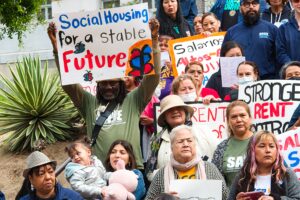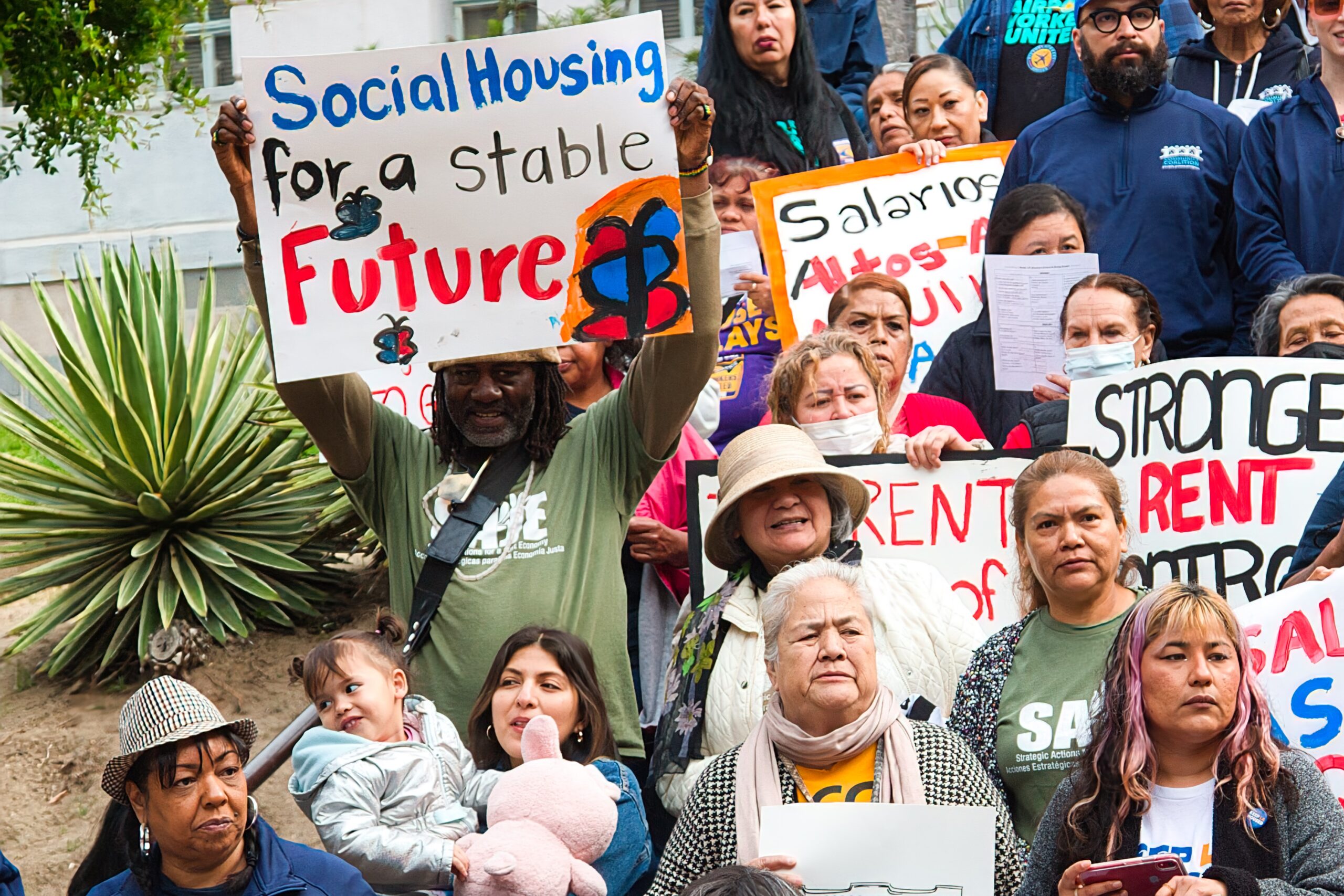
By the United Neighbors Against Displacement (UNIDAD) Coalition
June 25, 2024
The United Neighbors Against Displacement (UNIDAD) Coalition, which SAJE is a member of, supports codifying the Affordable Housing Streaming Ordinance. This ordinance will make it easier and cheaper to build much-needed housing in Los Angeles by expediting processing, clearances, and approvals for developments that are 100% affordable to renters at or below 80% of the Area Median Income. However, we ask that the Los Angeles City Council’s Planning and Land Use Management Committee first add strong tenant and environmental justice protections to the ordinance to preserve existing affordable housing, prevent the displacement of low-income communities of color and working-class Angelenos, and safeguard community health.
Streamlining should be unavailable or severely restricted when it will displace renters.
For almost two years, SAJE has been assisting with tenants who are being displaced under Mayor Karen Bass’s affordable housing streamlining directive ED1. Many do not know where they will move, or how they will afford to move, because housing is so unaffordable across Los Angeles. This is especially true for seniors on fixed incomes and for families who have lived in their units for 10 or more years.
Ideally, any residential rental unit occupied over the past 10 years should be ineligible for streamlining. This will ensure the ordinance does not have the perverse outcome of displacing low-income renters to build housing for low-income renters. A 10-year lookback is also key to ensuring property owners are deterred from pretextually displacing tenants prior to submitting streamlining applications with the city. Developers should be required to comply with the relocation, right of return, and right to remain obligations under the Housing Crisis Act of 2019 (as amended by SB 8 and AB 1218) and Government Code 7260 et seq., even if the project is exempt from those requirements under state law. The city should provide robust relocation services to assist displace tenants in securing comparable replacement housing in the same area.
The existing stock of healthy affordable housing must be preserved through a no net-loss policy.
Demolition of existing affordable housing should be a last resort. If affordable housing units are demolished, they should be replaced with units that serve a similar population, including similar square footage, bedroom/bathroom counts, and ELI and ALI levels.
The city should independently verify all tenant information and ensure that proper noticing happens over the life of the project.
In assisting tenants in rent-stabilized housing in South Los Angeles, SAJE has witnessed developers claiming that units set to be demolished for new affordable housing are vacant when they are in fact occupied, often by families. This is unacceptable, and we anticipate that the more streamlined the redevelopment process is, the more tenants will slip through the cracks. The city should track how many tenants are displaced by streamlining and ensure a transparent notification process for those who are. City departments should verify that the tenant information provided by the developer is accurate.
The ordinance should include a local preference policy.
We recommend a local preference policy for tenants displaced by streamlined development. This will make it easier for tenants to remain in their communities while they wait for the new housing to be built—a period that can take years. Displaced tenants should be able to choose from affordable units produced under this ordinance or the city’s various incentive programs (such as the Transit Oriented Communities program) in their Community Plan Area or within two miles of their former residence.
The city should require projects to complete a phase I environmental site review and, if warranted, a phase II environmental site review to determine if a site is contaminated.
If a site slated for development under this ordinance is found to be contaminated, the city should undertake a preliminary endangerment assessment to determine the existence of any hazardous substances on the site, determine the potential for exposure for future residents of the site, and evaluate current and past cleanup actions.
The city should require environmental assessments for developments located near hazardous sites.
This ordinance streamlines development in areas zoned for multifamily housing. These areas are often also home to industrial sites. For example, areas of South Los Angeles zoned for multifamily housing also contain oil drilling wells, such as the AllenCo Oil Production Facility in Signal Hill. For this reason, environmental assessments should be required for any development within 1,600 feet of a current industrial use or land zoned for future industrial use by right; within 3,200 feet of a facility that currently or previously extracts or refines oil or gas; or within 1,000 feet of freeways.

